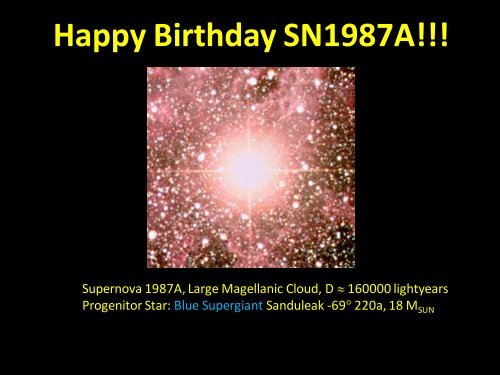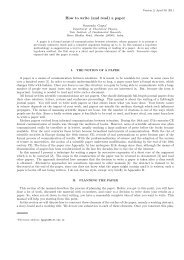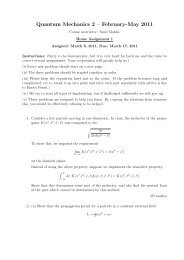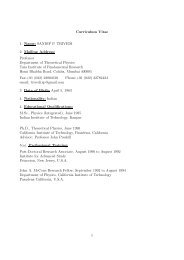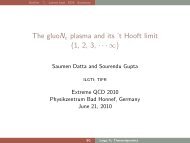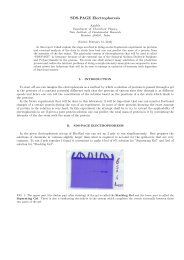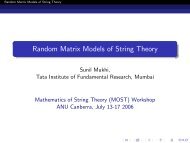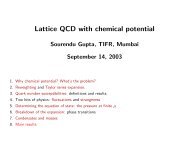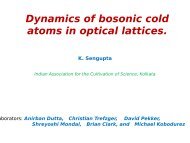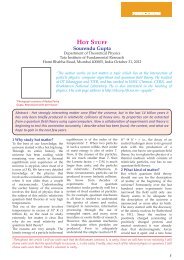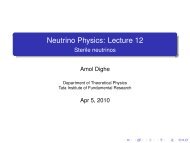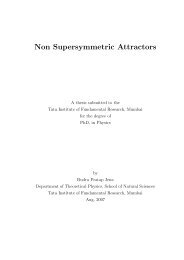Supernova explosions
Supernova explosions
Supernova explosions
Create successful ePaper yourself
Turn your PDF publications into a flip-book with our unique Google optimized e-Paper software.
Happy Birthday SN1987A!!!<br />
<strong>Supernova</strong> 1987A, Large Magellanic Cloud, D 160000 lightyears<br />
Progenitor Star: Blue Supergiant Sanduleak -69 220a, 18 M SUN
Simulations of Stellar Collapse,<br />
Core-Collapse <strong>Supernova</strong>e, and the<br />
Formation of Stellar-Mass Black Holes<br />
Christian David Ott<br />
cott@tapir.caltech.edu<br />
JIGSAW 2010, TIFR, Mumbai
Plan of this Talk<br />
Introduction and an Aside on the SN EOS<br />
Core-Collapse <strong>Supernova</strong> Mechanisms<br />
2D Angle-Dependent Neutrino Radiation-<br />
Hydrodynamics CCSN Simulations<br />
Observables of the CCSN Mechanism:<br />
Gravitational Waves and Neutrinos<br />
Failing Core-Collapse <strong>Supernova</strong>e and<br />
The Formation of Stellar-Mass Black Holes<br />
Bonus: Spectral swap in a 1D CCSN model
Core Collapse Timeline<br />
• Energy reservoir:<br />
few x 10 53 erg (100 B)<br />
• Explosion energy:<br />
1 B<br />
• Time frame for explosion:<br />
0.3 – 2.0 s after bounce.<br />
• BH formation at baryonic<br />
PNS mass 1.8 – 2.5 M SUN .<br />
C. D. Ott @ JIGSAW 2010, TIFR, Mumbai, 2010/02/23 4
The <strong>Supernova</strong> (Simulation) EOS<br />
• At high temperatures (T > 0.5 MeV) and densities:<br />
Nuclear Statistical Equilibrium (NSE) -> EOS function of (ρ, T, Y e ) alone.<br />
• Pressure contributions by: electrons, photons, baryons.<br />
• Core-collapse supernova simulations require robust EOS that covers:<br />
ρ: 10 4 – 10 15 g/cm 3 , T: 0.01 – 100 MeV, Y e : 0 – 0.6.<br />
Tabulated EOS with high density of points required for performance and<br />
thermodynamic consistency.<br />
• Two general approaches:<br />
1) “First Principles”: Many-body theory/(rel.)Hartree-Fock (mean-field) calculations:<br />
Hillebrandt & Wolf 1985, H. Shen et al. 1998.<br />
2) Phenomenological: Compressible liquid droplet model<br />
Lattimer & Swesty 1991 (LSEOS).<br />
• Key parameters governing stiffness: Nuclear symmetry energy S v and<br />
incompressiblity modulus K 0 .<br />
• In case you are interested: http://www.stellarcollapse.org/microphysics<br />
provides tabulated versions of HShen and LSEOS.<br />
C. D. Ott @ JIGSAW 2010, TIFR, Mumbai, 2010/02/23 5
Observed<br />
Neutron Star<br />
Masses<br />
?<br />
?<br />
Table provided by<br />
Jim Lattimer<br />
C. D. Ott @ JIGSAW 2010, TIFR, Mumbai,<br />
2010/02/23<br />
6
Neutron Star Masses (TOV, T=0.1 MeV, β equil.)<br />
M max (LS180) = 1.83 M Sun<br />
M max (LS220) = 2.04 M Sun<br />
M max (LS375) = 2.72 M Sun<br />
M max (HShen) = 2.24 M Sun<br />
Gravitational Mass<br />
C. D. Ott @ JIGSAW 2010, TIFR, Mumbai, 2010/02/23<br />
7
Neutron Star Masses (TOV, T=0.1 MeV, β equil.)<br />
M max (LS180) = 2.13 M Sun<br />
M max (LS220) = 2.41 M Sun<br />
M max (LS375) = 3.35 M Sun<br />
M max (HShen) = 2.61 M Sun<br />
Baryonic Mass<br />
C. D. Ott @ JIGSAW 2010, TIFR, Mumbai, 2010/02/23<br />
8
The Essence of Core-Collapse <strong>Supernova</strong><br />
Explosion Mechanisms<br />
Any explosion mechanism must tap the<br />
gravitational energy reservoir and convert the<br />
necessary fraction into energy of the explosion.<br />
C. D. Ott @ JIGSAW 2010, TIFR, Mumbai, 2010/02/23 9
Core-Collapse <strong>Supernova</strong> Mechanisms<br />
Neutrino<br />
Mechanism<br />
Magnetorotational<br />
Mechanism<br />
Acoustic<br />
Mechanism<br />
Introduced by:<br />
*Colgate & White ‘66, Arnett ‘66,<br />
Wilson ‘85, Bethe & Wilson ‘85+<br />
*LeBlanc & Wilson ‘70, Bisnovatyi-<br />
Kogan et al. ‘76, Meier et al. ‘76,<br />
Symbalisty ‘84+<br />
*proposed by Burrows et al. ‘06, ‘07;<br />
not yet confirmed by other groups/codes]<br />
Magneto-Viscous<br />
Mechanism<br />
*Akiyama et al. ‘03,<br />
Thompson et al. ‘05+<br />
Phase-Transition-<br />
Induced Mechanism<br />
[Migdal et al. ’71,<br />
Sagert et al. ‘09+<br />
C. D. Ott @ JIGSAW 2010, TIFR, Mumbai, 2010/02/23 10
Core-Collapse <strong>Supernova</strong> Simulations<br />
of the Princeton<br />
(Jerusalem/Caltech/Marseille/Seattle)<br />
Group with<br />
VULCAN/2D<br />
Adam Burrows (Princeton), Luc Dessart (Marseille), Eli Livne (Hebrew U),<br />
Jeremiah Murphy (U Washington), Christian D. Ott (Caltech)<br />
C. D. Ott @ JIGSAW 2010, TIFR, Mumbai, 2010/02/23 11
The VULCAN/2D Code<br />
[Livne 1993, Livne et al. 2004, Livne et al. 2007, Burrows et al. 2007, Ott et al. 2008]<br />
• Axisymmetric Newtonian Magnetohydrodynamics with rotation (2.5D).<br />
• Unsplit 2 nd order arbitrary Eulerian/Lagrangian (ALE) scheme.<br />
• Newtonian gravity, logically cylindrical coordinates, arbitrary mesh.<br />
• Radiation Transport:<br />
– multi-group flux-lim. diff. &<br />
angle-dependent transport.<br />
– Multiple energy groups,<br />
ν e , ν e , “ν μ ” species.<br />
– Slow-motion approximation.<br />
• Multiple finite-temperature<br />
nuclear EOS options.<br />
• Efficient parallelization in<br />
neutrino species/energy groups.<br />
Typical run size: 48–96 cores.<br />
VULCAN/2D Grid<br />
• Typical problem sizes:<br />
50k zones x O(50) vars (MGFLD)<br />
x O(50) for angle-dep. transport.<br />
C. D. Ott @ JIGSAW 2010, TIFR, Mumbai, 2010/02/23 12
Core-Collapse <strong>Supernova</strong> Mechanisms<br />
Neutrino<br />
Mechanism<br />
Magnetorotational<br />
Mechanism<br />
Acoustic<br />
Mechanism<br />
Introduced by:<br />
*Colgate & White ‘66, Arnett ‘66,<br />
Wilson ‘85, Bethe & Wilson ‘85+<br />
*LeBlanc & Wilson ‘70, Bisnovatyi-<br />
Kogan et al. ‘76, Meier et al. ‘76,<br />
Symbalisty ‘84+<br />
*proposed by Burrows et al. ‘06, ‘07;<br />
not yet confirmed by other groups/codes]<br />
Magneto-Viscous<br />
Mechanism<br />
*Akiyama et al. ‘03,<br />
Thompson et al. ‘05+<br />
Phase-Transition-<br />
Induced Mechanism<br />
[Migdal et al. ’71,<br />
Sagert et al. ‘09+<br />
C. D. Ott @ JIGSAW 2010, TIFR, Mumbai, 2010/02/23 13
Neutrino Mechanism<br />
[Ott et al. 2008]<br />
[Ott 2009]<br />
C. D. Ott @ JIGSAW 2010, TIFR, Mumbai, 2010/02/23 14
The Neutrino Mechanism<br />
[Wilson 1985, Bethe & Wilson 1985; recent reviews: Kotake et al. 2006, Janka et al. 2007, Murphy & Burrows 2008]<br />
• Neutrino cooling:<br />
• Neutrino heating:<br />
• Neutrino mechanism:<br />
Based on subtle imbalance<br />
between neutrino heating<br />
and cooling in the<br />
postshock region.<br />
Gain Radius<br />
Problem:<br />
Fails to explode massive<br />
stars in spherical symmetry.<br />
[Ott et al. 2008]<br />
[Thompson et al. 2003, Rampp & Janka 2002,<br />
Liebendörfer et al. 2002,2005]<br />
C. D. Ott @ JIGSAW 2010, TIFR, Mumbai, 2010/02/23 15
Status of the Neutrino Mechanism<br />
• Works for low-mass massive stars in spherical symmetry (1D):<br />
O-Ne cores with ZAMS M ≤ 9 M SUN . [Kitaura et al. 2006, Burrows et al. 2007c, Fischer et al. ‘09+<br />
• Dessart et al. ‘06,’07: 2D works in the case of accretion-induced<br />
collapse (AIC) of White Dwarfs to Neutron Stars.<br />
• Marek & Janka 2009: 2D + soft equation of state (EOS) + pseudogeneral-relativistic<br />
(GR) potential + ray-by-ray neutrino transport.<br />
-> late, weak explosion in 11.2 and 15 M SUN stars.<br />
• Bruenn, Mezzcappa, Messer et al. 2009 (conf. proceedings):<br />
2D + soft EOS + pseudo-GR potential + ray-by-ray MGFLD neutrino<br />
transport. -> early, strong <strong>explosions</strong> (disagreement with Marek & Janka?)<br />
• Ott et al. 2008: No neutrino-driven <strong>explosions</strong> in angle-dependent<br />
VULCAN/2D simulations (but: Shen EOS, Newtonian gravity).<br />
C. D. Ott @ JIGSAW 2010, TIFR, Mumbai, 2010/02/23 16
Core-Collapse <strong>Supernova</strong> Mechanisms<br />
Neutrino<br />
Mechanism<br />
Magnetorotational<br />
Mechanism<br />
Acoustic<br />
Mechanism<br />
Introduced by:<br />
*Colgate & White ‘66, Arnett ‘66,<br />
Wilson ‘85, Bethe & Wilson ‘85+<br />
*LeBlanc & Wilson ‘70, Bisnovatyi-<br />
Kogan et al. ‘76, Meier et al. ‘76,<br />
Symbalisty ‘84+<br />
*proposed by Burrows et al. ‘06, ‘07;<br />
not yet confirmed by other groups/codes]<br />
Magneto-Viscous<br />
Mechanism<br />
*Akiyama et al. ‘03,<br />
Thompson et al. ‘05+<br />
Phase-Transition-<br />
Induced Mechanism<br />
[Migdal et al. ’71,<br />
Sagert et al. ‘09+<br />
C. D. Ott @ JIGSAW 2010, TIFR, Mumbai, 2010/02/23 17
Free Energy of Differential Rotation<br />
• Lowest energy state of rotating body at fixed angular<br />
momentum is solid body rotation.<br />
• Differential rotation is a natural consequence of rotating collapse.<br />
*Ott et al. ’06+<br />
C. D. Ott @ JIGSAW 2010, TIFR, Mumbai, 2010/02/23<br />
18
Free Energy of Differential Rotation<br />
• Lowest energy state of rotating body at fixed angular<br />
momentum is solid body rotation.<br />
• Differential rotation is a natural consequence of rotating collapse.<br />
• -> “free energy” of differential<br />
rotation can be tapped by<br />
process(es) operating on<br />
rotational shear dΩ/dr.<br />
– Ω-dynamo (winding)<br />
– Magnetorotational Instability.<br />
(MRI)<br />
• Precollapse central iron-core<br />
periods < 4 s needed to supply<br />
> 1 B explosion energy.<br />
• Caveat: Vast majority of massive<br />
stars probably slow rotators<br />
with P c,0 > 10 s *Ott et al. ‘06, Heger et al. ‘05+.<br />
*Burrows et al. ’07+<br />
C. D. Ott @ JIGSAW 2010, TIFR, Mumbai, 2010/02/23<br />
19
MHD-driven Explosions<br />
[e.g., Burrows et al. 2007, Dessart et al. 2008, Shibata et al. 2006, Kotake et al. 2004, Yamada & Sawai 2004]<br />
• Rapid rotation:<br />
P 0 millisecond PNS<br />
• PNS rotational energy:<br />
10 B = 10 52 erg<br />
• Amplification of B fields up<br />
to equipartition:<br />
• compression<br />
• dynamos<br />
• magneto-rotational<br />
instability (MRI)<br />
• BUT: MRI not resolved.<br />
Ansatz: Start with large<br />
progenitor field to get<br />
final field as if MRI worked.<br />
• Jet-driven outflows.<br />
• MHD-driven explosion<br />
may be GRB precursor.<br />
VULCAN 2D R-MHD code, Livne et al. 2007, Burrows et al. 2007.<br />
C. D. Ott @ JIGSAW 2010, TIFR, Mumbai, 2010/02/23<br />
20
Newtonian<br />
Radiation-MHD<br />
Simulations with<br />
VULCAN/2D<br />
Magnetic field lines in<br />
M15B11UP2A1H of<br />
Burrows, Dessart,<br />
Livne, Ott, Murphy ‘07.<br />
C. D. Ott @ JIGSAW 2010, TIFR, Mumbai, 2010/02/23 21
Another Twist: Rotation & Convection<br />
C. D. Ott @ JIGSAW 2010, TIFR, Mumbai, 2010/02/23 22
Core-Collapse <strong>Supernova</strong> Mechanisms<br />
Neutrino<br />
Mechanism<br />
Magnetorotational<br />
Mechanism<br />
Acoustic<br />
Mechanism<br />
Introduced by:<br />
*Colgate & White ‘66, Arnett ‘66,<br />
Wilson ‘85, Bethe & Wilson ‘85+<br />
*LeBlanc & Wilson ‘70, Bisnovatyi-<br />
Kogan et al. ‘76, Meier et al. ‘76,<br />
Symbalisty ‘84+<br />
*proposed by Burrows et al. ‘06, ‘07;<br />
not yet confirmed by other groups/codes]<br />
Magneto-Viscous<br />
Mechanism<br />
*Akiyama et al. ‘03,<br />
Thompson et al. ‘05+<br />
Phase-Transition-<br />
Induced Mechanism<br />
[Migdal et al. ’71,<br />
Sagert et al. ‘09+<br />
C. D. Ott @ JIGSAW 2010, TIFR, Mumbai, 2010/02/23 23
Standing Accretion Shock Instability<br />
[e.g., Blondin et al. 2003,2006; Foglizzo et al. 2006, Scheck et al. 2006, 2007, Burrows et al. 2006, 2007 ]<br />
Advective-acoustic cycle<br />
drives shock instability.<br />
Seen in simulations by<br />
all groups!<br />
C. D. Ott @ JIGSAW 2010, TIFR, Mumbai, 2010/02/23 24
PNS core oscillations, Burrows et al. 2006, 2007; Ott et al. 2006<br />
25
Acoustic Mechanism<br />
[Burrows, Livne, Dessart, Ott, Murphy 2006, 2007b/c, Ott et al. 2006]<br />
• SASI-modulated supersonic accretion streams and SASI generated<br />
turbulence excite lowest-order (l=1) g-mode in the PNS. f 300 Hz.<br />
C. D. Ott @ JIGSAW 2010, TIFR,<br />
Mumbai, 2010/02/23<br />
• g-modes reach large amplitudes<br />
500 ms —1 s after bounce.<br />
• Damping by strong sound waves<br />
that steepen into shocks; deposit<br />
energy in the stalled shock.<br />
• 1 B <strong>explosions</strong> at late times.<br />
• (1) hard to simulate; unconfirmed,<br />
(2) possible parametric instability, limiting mode amplitudes. *Weinberg & Quatert’08+<br />
26
2D Angle-Dependent<br />
Neutrino Radiation-Hydrodynamics<br />
Core-Collapse <strong>Supernova</strong> Simulations<br />
Ott et al. 2008, ApJ<br />
with Adam Burrows (Princeton), Luc Dessart (Marseille),<br />
and Eli Livne (Hebrew University, Jerusalem)<br />
C. D. Ott @ JIGSAW 2010, TIFR, Mumbai, 2010/02/23 27
The First 2D Angle-Dependent Neutrino-RHD Simulations<br />
[Livne et al. 2004, Ott et al. 2008, Ott et al. 2009]<br />
• Method of short-characteristics S n<br />
[e.g. Castor 2004]<br />
• Evolution of the specific intensity.<br />
• 5D: 2D spatial,<br />
3D (є, θ, φ) momentum space.<br />
• At high optical depths: matching to diffusion approximation.<br />
• Comparison with multi-group flux-limited diffusion approximation.<br />
30 km 60 km 120 km 240 km<br />
C. D. Ott @ JIGSAW 2010, TIFR, Mumbai, 2010/02/23 28
Postbounce SN Models:<br />
• 20-solar mass star of Woosley, Heger & Weaver 2002. Shen EOS.<br />
• Nonrotating (s20.nr) and rotating model (s20.π, precollapse central P 0 = 2 s, 0 = π rad/s).<br />
• Evolved to 160 ms postbounce with MGFLD, then stationary-state S n solution.<br />
• Steady-State solutions with S 8 ,S 12 ,S 16 -> 40,92,162 total angular zones.<br />
• Long-term ( 400 ms) time-dependent calculations with S 8 .<br />
C. D. Ott @ JIGSAW 2010, TIFR, Mumbai, 2010/02/23 29
The Radiation Field<br />
30 km<br />
60 km<br />
120 km<br />
240 km<br />
C. D. Ott @ JIGSAW 2010, TIFR, Mumbai, 2010/02/23
Eddington Tensor Components<br />
• In axisymmetry and without velocity dependence:<br />
4 independent components (3 diagonal, 1 off-diagonal).<br />
(note: 1D/Ray-by-Ray -> only one “Eddington factor”)<br />
• Here: spherical coordinates; off-diagonal term K r small (
Comparing S n with MGFLD [Ott et al. 2008]<br />
rotating model<br />
160 ms<br />
nonrotating<br />
model<br />
160 ms<br />
• Improved, angle-dependent transport leads to greater heating (10-30%),<br />
larger shock radii / greater excursions.<br />
• Model appears to “settle” at new quasi-equilibrium.<br />
• But: No signs of explosion.<br />
C. D. Ott @ JIGSAW 2010, TIFR, Mumbai, 2010/02/23 32
Shock Radii<br />
• S n leads to somewhat larger shock radii / greater excursions.<br />
• Pronounced initial polar shock expansion in s20.π.<br />
Model appears to “settle” at new quasi-equilibrium.<br />
• No sign of explosion.<br />
• s20.π develops SASI at late times, faster/stronger in S n variant.<br />
C. D. Ott @ JIGSAW 2010, TIFR, Mumbai, 2010/02/23 33
Shock Radii<br />
Mazurek’s Law: [Ott et al. 2009, Jim Lattimer priv. comm.]<br />
(Jim Lattimer, priv. comm.)<br />
• S n leads to somewhat larger shock radii / greater excursions.<br />
• Pronounced initial polar shock expansion in s20.π.<br />
Model appears to “settle” at new quasi-equilibrium.<br />
• No sign of explosion.<br />
• s20.π develops SASI at late times, faster/stronger in S n variant.<br />
C. D. Ott @ JIGSAW 2010, TIFR, Mumbai, 2010/02/23 34
Observing the Explosion Mechanism<br />
Secondary<br />
Observables<br />
C. D. Ott @ JIGSAW 2010, TIFR, Mumbai, 2010/02/23<br />
Classical Observational Astronomy:<br />
• Explosion morphology, lightcurve,<br />
energy, chemical composition.<br />
• Progenitor type / mass.<br />
• Pulsar kicks.<br />
• Neutron star mass.<br />
35
Observing the Explosion Mechanism<br />
Neutrino and Gravitational Wave Astronomy<br />
• Direct “live” information from the supernova engine.<br />
• Gravitational Waves: Directly linked to the<br />
ubiquitous multi-D dynamics in the<br />
postshock region and in the PNS.<br />
C. D. Ott @ JIGSAW 2010, TIFR, Mumbai, 2010/02/23<br />
Chandra<br />
Primary<br />
Observables<br />
36
Gravitational Waves<br />
• Einstein equations in linear limit: Inhomogeneous wave<br />
equations -> Gravitational Waves.<br />
• 2 polarizations:<br />
• Emission: GWs are of leading order quadrupole waves.<br />
Emitted by accelerated aspherical bulk-mass motions.<br />
“Weak-field”, “slow-motion” limit:<br />
• GWs are weak and couple weakly<br />
to matter. Good: Little absorption/scattering Bad: Very difficult to observe.<br />
• Observation:<br />
Need to measure rel. displacements < 10 -20 .<br />
– Interferometers: LIGOs, LISA<br />
– Resonant mass detectors.<br />
LIGO Hanford<br />
2 km & 4 km interferometers<br />
C. D. Ott @ CASS UCSD 2009/11/18 37
Gravitational Wave Astronomy<br />
C. D. Ott @ Århus 19/02/2009 38
Gravitational Wave Detection<br />
seismic / local<br />
gravity gradients<br />
thermal<br />
photon shot noise<br />
-> Enhanced versions of LIGO and VIRGO currently taking data!<br />
C. D. Ott @ CASS UCSD 2009/11/18 39
Gravitational-Wave Signatures of<br />
Core-Collapse <strong>Supernova</strong> Mechanisms<br />
*Ott ‘08, ’09, Classical & Quantum Gravity+<br />
Still to be addressed / work in progress:<br />
Neutrino Signatures of<br />
Core-Collapse <strong>Supernova</strong> Mechanisms<br />
C. D. Ott @ JIGSAW 2010, TIFR, Mumbai, 2010/02/23 40
Blowing up Massive Stars:<br />
Core-Collapse SN Mechanisms<br />
Neutrino<br />
Mechanism<br />
Magnetorotational<br />
Mechanism<br />
Acoustic<br />
Mechanism<br />
C. D. Ott @ JIGSAW 2010, TIFR, Mumbai, 2010/02/23 41
Blowing up Massive Stars:<br />
Core-Collapse SN Mechanisms<br />
Neutrino<br />
Mechanism<br />
Dominant Multi-D Dynamics and<br />
GW Emission Processes<br />
Magnetorotational<br />
Mechanism<br />
Acoustic<br />
Mechanism<br />
C. D. Ott @ JIGSAW 2010, TIFR, Mumbai, 2010/02/23 42
Blowing up Massive Stars:<br />
Core-Collapse SN Mechanisms<br />
Neutrino<br />
Mechanism<br />
Dominant Multi-D Dynamics and<br />
GW Emission Processes<br />
Convection and SASI.<br />
Magnetorotational<br />
Mechanism<br />
Acoustic<br />
Mechanism<br />
C. D. Ott @ JIGSAW 2010, TIFR, Mumbai, 2010/02/23 43
Blowing up Massive Stars:<br />
Core-Collapse SN Mechanisms<br />
Neutrino<br />
Mechanism<br />
Dominant Multi-D Dynamics and<br />
GW Emission Processes<br />
Convection and SASI.<br />
Magnetorotational<br />
Mechanism<br />
Rotating core collapse & bounce,<br />
PNS rotational instabilities.<br />
Acoustic<br />
Mechanism<br />
C. D. Ott @ JIGSAW 2010, TIFR, Mumbai, 2010/02/23 44
Blowing up Massive Stars:<br />
Core-Collapse SN Mechanisms<br />
Neutrino<br />
Mechanism<br />
Dominant Multi-D Dynamics and<br />
GW Emission Processes<br />
Convection and SASI.<br />
Magnetorotational<br />
Mechanism<br />
Rotating core collapse & bounce,<br />
PNS rotational instabilities.<br />
Acoustic<br />
Mechanism<br />
PNS pulsations.<br />
C. D. Ott @ JIGSAW 2010, TIFR, Mumbai, 2010/02/23 45
Rapidly Rotating Stellar Collapse in 3+1 GR<br />
3D GR simulation Ott et al., rendition by R. Kähler, Zuse Institute, Berlin<br />
C. D. Ott @ JIGSAW 2010, TIFR, Mumbai, 2010/02/23 46
GWs from Rotating Collapse & Rotational Instability<br />
nonaxisymmetric<br />
postbounce dynamics<br />
[Ott 2009b, CQG]<br />
axisymmetric<br />
core bounce<br />
See:<br />
Ott et al. ‘07,<br />
Ott ‘09a,b<br />
Scheidegger et al. ’08, ‘09<br />
C. D. Ott @ JIGSAW 2010, TIFR, Mumbai, 2010/02/23 47
The GW Signature of Convection and SASI<br />
[Murphy, Ott and Burrows 2009]<br />
C. D. Ott @ JIGSAW 2010, TIFR, Mumbai, 2010/02/23 48
Convection/SASI GW Time-Frequency Evolution<br />
[Murphy, Ott & Burrows 2009]<br />
C. D. Ott @ JIGSAW 2010, TIFR, Mumbai, 2010/02/23<br />
49
GWs from PNS Core Pulsations in the Context of the<br />
Acoustic Mechanism<br />
Convection & SASI<br />
Core Bounce /<br />
Prompt Convection<br />
early pulsations<br />
late-time<br />
PNS pulsations<br />
[Ott 2009ab, Ott et al. 2006]<br />
C. D. Ott @ JIGSAW 2010, TIFR, Mumbai, 2010/02/23 50
PNS Pulsations: GW T-F Evolution<br />
s25WW of Ott et al. 2006<br />
C. D. Ott @ JIGSAW 2010, TIFR, Mumbai, 2010/02/23 51
Blowing up Massive Stars:<br />
Core-Collapse SN Mechanisms<br />
Neutrino<br />
Mechanism<br />
Dominant Multi-D Dynamics and<br />
GW Emission Processes<br />
Convection and SASI.<br />
Magnetorotational<br />
Mechanism<br />
Rotating core collapse & bounce,<br />
PNS rotational instabilities.<br />
Acoustic<br />
Mechanism<br />
PNS pulsations.<br />
-> Ott CQG 26, 204015 (2009):<br />
-> Clear mapping between explosion<br />
mechanism and GW signature.<br />
C. D. Ott @ JIGSAW 2010, TIFR, Mumbai, 2010/02/23 52
Adding Neutrinos to the Mix: (work in progress)<br />
Potential Neutrino Signature<br />
Neutrino<br />
Mechanism<br />
High-frequency variations of L ν (e,ebar)<br />
Magnetorotational<br />
Mechanism<br />
Very soft spectrum along equator,<br />
Very hard spectrum along poles.<br />
Acoustic<br />
Mechanism<br />
High-frequency variations of L ν ,<br />
including ν x . Long delay to<br />
explosion (> 0.8-1 s).<br />
Key: Use combined neutrino/GW information to break<br />
observational degeneracies.<br />
C. D. Ott @ JIGSAW 2010, TIFR, Mumbai, 2010/02/23 53
The Formation of Black Holes in<br />
Failing Core-Collapse <strong>Supernova</strong>e<br />
with Evan O’Connor (Caltech), Uli Sperhake (Caltech),<br />
and Erik Schnetter (LSU), Peter Diener (LSU) ,<br />
Frank Löffler (LSU), Adam Burrows (Princeton)<br />
C. D. Ott @ JIGSAW 2010, TIFR, Mumbai, 2010/02/23 54
Core Collapse Timeline<br />
• Energy reservoir:<br />
few x 10 53 erg (100 B)<br />
• Explosion energy:<br />
1 B<br />
• How much time is there for the CCSN<br />
mechanism to work?<br />
• What stars don’t make it and form BHs?<br />
• What stars explode, but make BHs by<br />
• Time fallback frame for accretion? explosion:<br />
• 0.3 What – 1.5 is s after the connection bounce. to GRBs.<br />
• BH • To formation date: No at systematic baryonic studies that take full<br />
PNS CCSN massphysics 1.8 – into 2.5 account, M SUN . but see work by<br />
Fryer et al., Sumiyoshi et al., Fischer et al.<br />
C. D. Ott @ JIGSAW 2010, TIFR, Mumbai, 2010/02/23 55
Simulations of BH Formation<br />
• Published work:<br />
1D: Lagrangian GR radiation-hydro, very few detailed models.<br />
*Sumiyoshi et al. ’06, ‘07, ’08; Fischer et al. 2009+<br />
2D/3D: Polytropic/Gamma-Law models; collapse of isolated NS or<br />
collapsing polytropes. No microphysics/neutrinos.<br />
[Baiotti et al., Shibata & Sekiguchi]<br />
• Our new approach: *O’Connor & Ott 2009, Ott et al. 2010 (in prep.)+<br />
• Goals: (1) Study systematics of BH formation in the limiting case of<br />
spherical symmetry.<br />
(2) Develop efficient microphysics technology/approximations for<br />
multi-D simulations.<br />
(3) Study long-term postbounce evolution, BH formation, and<br />
late-time evolution in 3D GR using the Cactus Framework.<br />
-> 5 year NSF PetaApps award PetaCactus (LSU/Caltech/Princeton)<br />
C. D. Ott @ JIGSAW 2010, TIFR, Mumbai,<br />
2010/02/23<br />
56
GR1D<br />
• GR1D: Open-Source 1.5D GR hydrodynamics code. [O’Connor & Ott 2009+<br />
• Available from http://www.stellarcollapse.org .<br />
• Radial-gauge, polar-slicing (-> Schwarzschild-like coordinates).<br />
• Shellular rotation (hence, 1.5D).<br />
• High-resolution shock-capturing<br />
hydro, PPM reconstruction, HLLE solver.<br />
• Multiple finite-temperature microphysical EOS:<br />
H. Shen et al. 1998, Lattimer & Swesty 1991 with K={180,220,375} MeV.<br />
EOS tables available in HDF5 format on http://www.stellarcollapse.org .<br />
• 3-flavor, energy-averaged (gray) neutrino leakage and approximate<br />
neutrino heating.<br />
C. D. Ott @ JIGSAW 2010, TIFR, Mumbai,<br />
2010/02/23<br />
57
Example: Black Hole Formation in Failing<br />
Core-Collapse <strong>Supernova</strong>e<br />
*O’Connor & Ott 2009, see also Sumiyoshi et al. 2006, 2007, 2008, Fischer et al. 2009+<br />
Radius (km)<br />
Radius (km)<br />
Animations by Evan O’Connor<br />
C. D. Ott @ JIGSAW 2010, TIFR, Mumbai,<br />
2010/02/23<br />
58
There Is No Direct BH Formation!<br />
• Generic: M IC = M PNS at bounce ≈ 0.4 – 0.7 M Sun . Set by nuclear physics,<br />
electron capture and general collapse hydrodynamics.<br />
• Inner core easily stabilized by stiff core of the nuclear force + nucleon<br />
degeneracy. Exception: Very massive stars, M > 100 M Sun<br />
• All ‘ordinary’ massive stars undergo a PNS phase before BH formation.<br />
C. D. Ott @ JIGSAW 2010, TIFR, Mumbai,<br />
2010/02/23<br />
59
Equation of State Dependence<br />
Cold NS mass data:<br />
M max (LS180) = 2.13 M Sun<br />
M max (LS220) = 2.41 M Sun<br />
M max (HShen) = 2.61 M Sun<br />
M max (LS375) = 3.35 M Sun<br />
40-M Sun model,<br />
Woosley & Weaver 1995,<br />
no mass loss<br />
*O’Connor & Ott 2010 in prep.+ C. D. Ott @ JIGSAW 2010, TIFR, Mumbai,<br />
2010/02/23<br />
60
Comparison with Full Transport<br />
Fischer et al. 2009<br />
GR1D<br />
• GR1D reproduces full transport to 25% in terms of Lnu and to 10%<br />
in terms of the time of BH formation, but is roughly 10 times faster.<br />
-> allows for parameter study.<br />
C. D. Ott @ JIGSAW 2010, TIFR, Mumbai, 2010/02/23<br />
61
Precollapse Stellar Structure<br />
Single massive stars<br />
Different mass loss<br />
prescriptions.<br />
*O’Connor & Ott 2010 in prep.+<br />
C. D. Ott @ JIGSAW 2010, TIFR, Mumbai,<br />
2010/02/23<br />
62
Precollapse Stellar Structure<br />
*O’Connor & Ott 2010 in prep.+<br />
C. D. Ott @ JIGSAW 2010, TIFR, Mumbai,<br />
2010/02/23<br />
63
Variations in ZAMS Mass<br />
*O’Connor & Ott 2010 in prep.+<br />
C. D. Ott @ JIGSAW 2010, TIFR, Mumbai,<br />
2010/02/23<br />
64
Metallicity / Mass Loss<br />
40-solar-mass star with different<br />
initial composition and<br />
mass-loss prescriptions.<br />
*O’Connor & Ott 2010 in prep.+<br />
C. D. Ott @ JIGSAW 2010, TIFR, Mumbai,<br />
2010/02/23<br />
65
on to 3D ...<br />
C. D. Ott @ JIGSAW 2010, TIFR, Mumbai,<br />
2010/02/23<br />
66
Computational Framework<br />
Cactus [http://www.cactuscode.org]<br />
• Open-source software framework for HPC, developed at the<br />
Center for Computation & Technology at LSU.<br />
• Includes tools for code development, dynamic simulation<br />
control, data analysis, visualization, data handling (HDF5).<br />
• Manage increased complexity with high-level abstractions,<br />
e.g. for inter-node communication, multi-core parallelism, I/O<br />
• Active user community since 1998 in numerical relativity, fluid<br />
dynamics, and quantum gravity.<br />
Carpet [http://www.carpetcode.org]<br />
• Open-source driver for Adaptive Mesh<br />
Refinement (AMR) and multi-block systems.<br />
• Developed by Erik Schnetter (LSU).<br />
• Full vertex-centered and cell-centered<br />
Berger-Oliger AMR with sub-cycling in time.<br />
C. D. Ott @ JIGSAW 2010, TIFR, Mumbai, 2010/02/23 67
Spacetime Evolution: McLachlan<br />
• State-of-the-art Einstein solver, high-order finite differencing (up to 8 th )<br />
• Code is automatically generated with the Kranc package via<br />
Mathematica (equations contain 5000 terms).<br />
• Optimized for hybrid OpenMP/MPI.<br />
• Developed in NSF-funded CIGR/XiRel collaboration (LSU, GA Tech, RIT, Caltech),<br />
available as open source. [Brown et al. 2007, 2009]<br />
MHD, Microphysics & Neutrinos:<br />
Zelmani GR Core-Collapse Package<br />
• High-resolution Shock-Capturing hydrodynamics with PPM reconstruction<br />
based on the open-source GRHD code Whisky/Avanti.<br />
Extension to GRMHD in development.<br />
• Multiple finite-temperature nuclear EOS options.<br />
Neutrino leakage and heating scheme *O’Connor & Ott ‘09+.<br />
C. D. Ott @ JIGSAW 2010, TIFR, Mumbai, 2010/02/23<br />
68
C. D. Ott @ JIGSAW 2010, TIFR, Mumbai,<br />
2010/02/23<br />
69
What this just was...<br />
[Ott et al. 2010 in prep.]<br />
• Exploratory calculation: 3D, but restricted to octant.<br />
– 40-solar-mass Woosley & Weaver 1995 progenitor.<br />
– Simplified hybrid EOS: Piecewise polytrope with thermal component,<br />
Γ 1 = 1.30, Γ 2 =2.00,<br />
Γ th = 1.30.<br />
Mimics stiffening of EOS &<br />
effects of dissociation and<br />
deleptonization.<br />
– Moderate rotation,<br />
Ω 0 = 1 rad/s.<br />
– 11 levels of MR,<br />
using hydro excision.<br />
– More realistic 3D models<br />
running right now.<br />
dτ = α dt<br />
Mass<br />
inside<br />
horizon<br />
C. D. Ott @ JIGSAW 2010, TIFR, Mumbai, 2010/02/23<br />
70
Bonus Slides<br />
Faking it:<br />
An Ad-Hoc Test of the Effect of<br />
Self-Induced Flavor Oscillations<br />
on Core-Collapse <strong>Supernova</strong> Dynamics<br />
Ott et al. 2010 in preparation<br />
C. D. Ott @ JIGSAW 2010, TIFR, Mumbai, 2010/02/23<br />
71
Setup<br />
• Following Fogli et al. ‘07, ‘08.<br />
• IH, split at 7 MeV (electron neutrinos), 2 MeV (antis)<br />
• 12 solar mass progenitor, 100 ms after core bounce.<br />
Code: 1D Version of VULCAN/2D.<br />
• Assume: Ad-hoc spectral swap manifest at R = 90 km.<br />
C. D. Ott @ JIGSAW 2010, TIFR, Mumbai, 2010/02/23<br />
72
Result<br />
• Huge increase in instantaneous heating rate.<br />
C. D. Ott @ JIGSAW 2010, TIFR, Mumbai, 2010/02/23<br />
73
Dynamical Impact<br />
• Another case of Mazurek’s law? Still checking simulation...<br />
C. D. Ott @ JIGSAW 2010, TIFR, Mumbai, 2010/02/23<br />
74
Dynamical Impact<br />
Next steps:<br />
• Verify 1D simulation.<br />
• Study in well-proven VULCAN/2D.<br />
• Implement more consistent yet simple<br />
“operator-split” approach using oscillation<br />
code to predict where/how splits occur<br />
(anybody interested in a collaboration?).<br />
• Another case of Mazurek’s law? Still checking simulation...<br />
C. D. Ott @ JIGSAW 2010, TIFR, Mumbai, 2010/02/23<br />
75
Summary<br />
• Multi-D core-collapse supernova simulations are maturing<br />
-> 3 potential explosion mechanisms:<br />
neutrino, magnetorotational, acoustic<br />
• The gravitational-wave signature of the 3 considered mechanisms<br />
is likely to be mutually exclusive. Neutrinos will help as well.<br />
• Galactic core-collapse SN would allow to constrain SN mechanism.<br />
• Ordinary massive stars don’t collapse directly to BHs.<br />
There is always a protoneutron star phase of 0.2 to multiple seconds.<br />
• First 3D models of BH formation in failing CCSNe -- more realistic<br />
models to come soon.<br />
• First (very preliminary) results on the potential dynamical impact<br />
of self-induced neutrino oscillations on the CCSN mechanism.<br />
C. D. Ott @ JIGSAW 2010, TIFR, Mumbai, 2010/02/23 76
Supplemental Slides<br />
C. D. Ott @ JIGSAW 2010, TIFR, Mumbai, 2010/02/23 77
Fully coupled!<br />
Understanding the Core-Collapse SN Mechanism<br />
• Core-Collapse <strong>Supernova</strong> Physics:<br />
Magneto-Hydrodynamics / Plasma Physics<br />
Dynamics of the stellar fluid.<br />
General Relativity<br />
Nuclear and Neutrino Physics<br />
Transport Theory<br />
Gravity<br />
Nuclear EOS, nuclear<br />
reactions & ν interactions.<br />
Neutrino transport.<br />
• Additional Complication: The Multi-D Nature of the Beast<br />
– Rotation, fluid instabilities (convection, turbulence, advective-acoustic,<br />
rotational), MHD dynamos, precollapse multi-D perturbations.<br />
-> Need multi-D (ideally 3D) treatment.<br />
• Route of Attack: Computational Modeling<br />
– First 1D computations in the late 1960’s: Colgate & White, Arnett, Wilson<br />
– Best current simulations still 1D.<br />
– Good 2D Models (with various approximations [Gravity/Transport]).<br />
– First 3D Models.<br />
C. D. Ott @ JIGSAW 2010, TIFR, Mumbai, 2010/02/23 78
Testing the Acoustic Mechanism<br />
• So far no independent confirmation of the acoustic mechanism.<br />
• Overstable physical g-modes PNS shown to exist.<br />
• Questions:<br />
– Do modes reach amplitudes as high as seen in our calculations?<br />
– Effects of GR and 3D?<br />
• Fundamental prerequisite for non-linear numerical tests of mode excitation:<br />
Grid must be singularity free & allow change of the core’s geometric center.<br />
• Marek & Janka ‘09:<br />
Modes shown to exist, but don’t reach high<br />
amplitudes. But: (1) Amplitudes become high<br />
only at t > 0.6 - 0.8 s<br />
VULCAN/2D grid<br />
(not simulated),<br />
(2) MJ09 grid not<br />
singularity free.<br />
-> Acoustic Mech.<br />
not yet numerically<br />
ruled out.<br />
[Ferrari et al. 2003, 2007; Yoshida et al. 2007]<br />
C. D. Ott @ JIGSAW 2010, TIFR, Mumbai, 2010/02/23<br />
79
C. D. Ott @ JIGSAW 2010, TIFR, Mumbai,<br />
2010/02/23<br />
80
Precollapse Stellar Structure<br />
Single massive<br />
stars<br />
C. D. Ott @ JIGSAW 2010, TIFR, Mumbai,<br />
2010/02/23<br />
81
Computational Cost & Scaling<br />
[Based on GR+GRHD]<br />
• 9 levels of refinement, each 400 3 zones, 400 3D grid functions<br />
-> Memory footprint > 2 TB (including inter-process buffers)<br />
• 1 single-zone update: 50 kflop; total timesteps: 1 M (fine grid).<br />
-> 1500 Petaflops. Factor 5-10 larger with radiation transport.<br />
(Franklin results are extrapolated<br />
from Black Hole scaling test)<br />
Weak scaling of a 9-level AMR test calculation of<br />
the coupled GR + GRHD system, evolving a neutron star.<br />
C. D. Ott @ JIGSAW 2010, TIFR, Mumbai, C. 2010/02/23 D. Ott @ JIGSAW 2010, TIFR, Mumbai, 2010/02/23 82
Precollapse Stellar Structure<br />
Single massive<br />
stars<br />
C. D. Ott @ JIGSAW 2010, TIFR, Mumbai,<br />
2010/02/23<br />
83
Testing GRB Progenitors<br />
[Dessart, Burrows, Livne, Ott, Murphy, ApJL 2008]<br />
• Necessary specific angular momentum to make a<br />
disk around a maximally spinning Kerr BH:<br />
j > 1.5 x 10 16 (M BH /3M SUN ) cm 2 /s.<br />
-> need rapidly rotating progenitor star.<br />
• Basic question:<br />
Can rapid rotation +<br />
MHD inhibit BH<br />
formation and a GRB?<br />
-> Newtonian MHD<br />
simulations with<br />
VULCAN/2D.<br />
C. D. Ott @ JIGSAW 2010, TIFR, Mumbai, 2010/02/23 84
Testing GRB Progenitors<br />
[Dessart, Burrows, Livne, Ott, Murphy, ApJL 2008]<br />
• Model 35OC from Woosley & Heger 2006;<br />
original precollapse rotational configuration.<br />
• Initial B-field: Two models<br />
M0: 2 x 10 10 G toroidal, 8 x 10 11 G poloidal (progenitor model)<br />
M1: 2 x 10 10 G toroidal, 4 x 10 12 G poloidal.<br />
C. D. Ott @ JIGSAW 2010, TIFR, Mumbai, 2010/02/23 85
Testing GRB Progenitors<br />
[Dessart, Burrows, Livne, Ott, Murphy, ApJL 2008]<br />
• Rapid rotation + MHD<br />
can inhibit (or delay)<br />
BH formation in GRB<br />
progenitors.<br />
• Standard Collapsar<br />
scenario may not work<br />
as straightforwardly as<br />
thought.<br />
C. D. Ott @ JIGSAW 2010, TIFR, Mumbai, 2010/02/23 86


